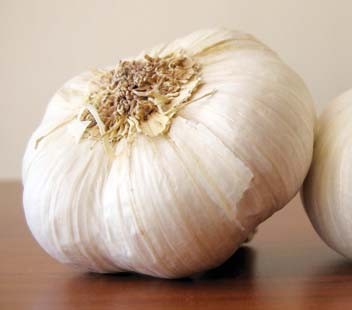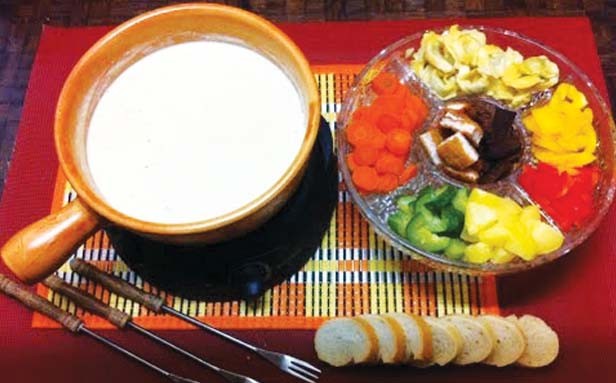Recipes that call for lots of garlic are always best when they’re made with new crop garlic, which is making its first appearance at farm stands and local farmers markets.
New crop garlic’s flavor is intense but sweeter and less harsh (especially when raw) than that of garlic available in late winter. I don’t have scientific proof, but new crop garlic doesn’t seem to linger on the palate as much, either, which is a fancy way of saying that it’s less likely to give the diner bad garlic breath.
Actually, what seems to be the biggest culprit in the bad breath sweepstakes is the pre-minced garlic that comes in a jar. It’s certainly convenient, but whenever I eat something made with pre-minced garlic, I feel like the Pigpen character in Peanuts, with a cloud of stale garlic odor hovering around me instead of dust and dirt.
Many recipes – chicken with 40 garlic cloves and the garlicky mayonnaise called aioli, to name just two – call for lots of garlic. While new crop or green garlic is preferable to use in any recipe, I think it’s essential in any dish that uses a lot of garlic.
One of the best is bagna cauda. A specialty of the northwestern Italian region of Piedmont, bagna cauda means “hot bath.” It’s especially appropriate for summer, not only because of the quantity of fresh garlic used but also because lovely seasonal young vegetables are dipped into it.
There are just three ingredients in traditional Italian bagna cauda: garlic, anchovies and olive oil. Cream, milk, or both are included in most Italian-American recipes I’ve seen or tasted. I’m not sure why, but I suspect the reason cream became a component here in America is that in much of America, cream would have been a more readily available and far less expensive ingredient than olive oil. That certainly would have been the case in the Midwest, especially in small towns such as Kincaid, where bagna cauda is featured at their annual garlic festival.
Regardless of the reason, I prefer versions that contain cream and milk, such as the one in the accompanying recipe. It makes the bagna cauda smoother and more mellow, a hot bath worth dipping into again and again.
Bagna cauda is most often served in the U.S. as an appetizer, but when a wide variety of fresh vegetables are used it can work as an entire meal. Though not traditional, cooked proteins such as shrimp or cubes of chicken are delicious when they’ve taken a garlic bath, too.
If you love garlic but hate anchovies, chances are you’ll still enjoy bagna cauda. Garlic is the star of the party here; the anchovies just add tang and depth of flavor, as they do in Worcestershire sauce and the classic Caesar salad dressing.
Salt anchovies’ flavor is milder than that of oil-cured anchovies. The downside – at least anywhere in the U.S. I’ve been outside of New York where salt anchovies can be purchased by the ounce – is that salt anchovies only come in a fairly large can. But once opened, the can’s contents can be transferred to a nonreactive container and refrigerated indefinitely as long as the remaining anchovies are covered with salt.
I stumbled across the method of preparing bagna cauda in a food processor by accident. It doesn’t change the flavor; it just makes the sauce creamier. Refrigerated leftover bagna calda makes a delicious spread to use on sandwiches such as tuna or cheese; combined with a wine, balsamic or sherry vinegar to taste for a creamy salad dressing; and tossed with fettuccini or linguini and some sautéed or steamed shellfish (shrimp, calamari, scallops, mussels, clams, etc.) for a phenomenal seafood pasta. Use about 1 cup bagna cauda for 8 ounces pasta.
Bagna cauda
- 1 1/2 c. whole milk
- 6 salt-cured anchovies or 12 oil-packed anchovy fillets (more or fewer to taste)
- 2 large heads of garlic (between 2/3 and 1 c. peeled cloves, the freshest you can find) OR 1 1/2 c. sliced green garlic (before the heads have completely formed), green and white parts kept separate
- 1/4 c. heavy cream
- 1 T. unsalted butter
- 3/4 c. extra-virgin olive oil
- Freshly ground pepper
- Salt, optional
Separate the cloves of garlic and peel them. If your garlic is very young and fresh, you may not have to peel the cloves. Add the garlic cloves or white parts of green garlic to the milk in the saucepan and bring the pan to a simmer over medium-low heat. Simmer, uncovered, for 15 to 20 minutes, then add the chopped anchovies (and green parts of green garlic if using) and continue simmering until the milk has thickened and is barely coating the pan but has not completely evaporated.
Traditionally bagna cauda is completed by mashing the softened garlic and anchovies and then whisking in the remaining ingredients. For an alternative that produces a creamy light sauce, heat the olive oil, cream and butter in a separate pan until the mixture is well warmed but not smoking hot. Scrape the garlic-anchovy mixture into a blender or food processor. Purée it for a couple of minutes until smooth and then, with the motor running, pour in the warm oil, cream and butter mixture in a thin stream. It should emulsify into a consistency similar to that of mayonnaise. Adjust the seasoning – if using salt anchovies it will probably not need additional salt.
Transfer the bagna cauda to a small chafing dish or fondue pot. Serve immediately alongside a platter of the items to be dipped, keeping the bagna cauda warm but not hot. Leftover bagna cauda may be refrigerated and kept for up to two weeks. Be careful to reheat it gently if you’ve used the food processor method to prevent separation.
Salt anchovies can be purchased locally at Angela’s Taste of Italy (1535 S. MacArthur Blvd., 217-787-7922).
Some dipping possibilities:
- steamed asparagus spears
- steamed or raw zucchini and summer squash
- cherry tomatoes
- pepper strips
- cooked small new potatoes
- cabbage leaves, cut into portions about the size of a small inner leaf of romaine lettuce
- celery
- scallions
- carrots
- lightly steamed broccoli and cauliflower cooked artichokes and cardoons




















